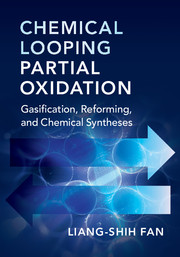Book contents
- Frontmatter
- Dedication
- Epigraph
- Contents
- In Cooperation with Professor Fan's Research Group Members
- Preface
- Nomenclature
- Abbreviations
- 1 Overview
- 2 Metal Oxide Oxygen Carriers
- 3 Oxidative Coupling of Methane
- 4 Syngas Generation
- 5 Catalytic Metal Oxides and Applications
- 6 Process Simulations and Techno-Economic Analyses
- Index
- Color plate section
Preface
Published online by Cambridge University Press: 07 November 2017
- Frontmatter
- Dedication
- Epigraph
- Contents
- In Cooperation with Professor Fan's Research Group Members
- Preface
- Nomenclature
- Abbreviations
- 1 Overview
- 2 Metal Oxide Oxygen Carriers
- 3 Oxidative Coupling of Methane
- 4 Syngas Generation
- 5 Catalytic Metal Oxides and Applications
- 6 Process Simulations and Techno-Economic Analyses
- Index
- Color plate section
Summary
This book is written as a sequel to an earlier book, entitled “Chemical Looping Systems for Fossil Energy Conversions,” published in 2010 by Wiley/AICHE. For the earlier book, the motivation was to elucidate the rationale for the resurgence of chemical looping technology research and development related to the ease in CO2 emission control and the enhancement in exergy conversion efficiency for combustion of carbonaceous fuels. The earlier book clearly indicated that the success of chemical looping technology depends strongly on the viability of the metal oxide materials for its redox applications. Knowledge of fundamental properties of these materials such as redox phase behavior, reactivity, recyclability, and metal oxide support is essential for characterizing chemical looping system performance for the conversion of coal, natural gas, petrochemicals, and biomass. Furthermore, it elaborated gasification or reforming processes involving syngas generation from traditional coal gasifiers, and the use of syngas as feedstock for hydrogen production through a steam–iron chemical looping reaction scheme. It also covered traditional methane–steam reforming applications that are coupled with chemical looping heating schemes, followed by water–gas shift reactions for hydrogen generation. Chemical looping process simulations based on Aspen Plus® utilizing reactors such as gasifier, reducer, oxidizer, combustor, and processes such as conventional gasification and chemical looping for electricity and liquid fuel production were presented.
My motivation for writing this book was precipitated by the exciting recent revelation of direct, one-step, chemical looping partial oxidation techniques in gasifiers and reformers using carbonaceous feedstock. These techniques can produce syngas of a high quality, leading to process efficiencies far greater than any traditional gasification or reforming techniques and other chemical looping techniques. The implications of this discovery are significant in that syngas compositions can reach to near the thermodynamic conversion limit with a H2:CO molar ratio that can readily be used for direct downstream chemicals or liquid fuels synthesis. The uniqueness of these gasification and reforming techniques is that the syngas stream from the chemical looping reducer reactor will contain little CO2, yielding a process of high carbon utilization efficiency. Even higher carbon utilization efficiencies can be achieved in a chemical looping process scheme for chemicals or liquid fuels production when the CO2 generated from the process system can be fully recycled to the reducer reactor, yielding a CO2 neutral chemical looping process system.
- Type
- Chapter
- Information
- Chemical Looping Partial OxidationGasification, Reforming, and Chemical Syntheses, pp. xv - xviiiPublisher: Cambridge University PressPrint publication year: 2017

